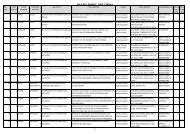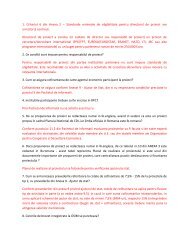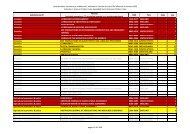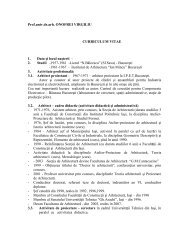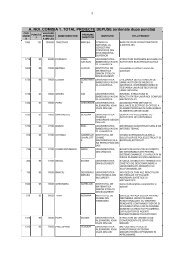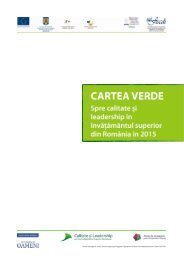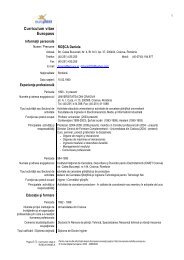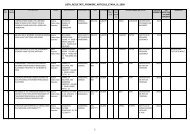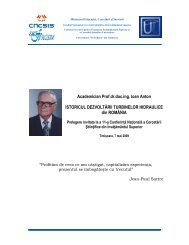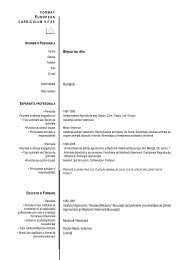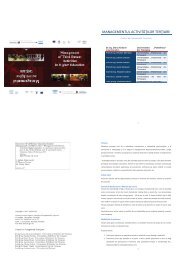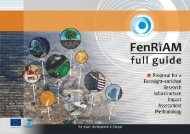Povesti de succes - uefiscdi
Povesti de succes - uefiscdi
Povesti de succes - uefiscdi
You also want an ePaper? Increase the reach of your titles
YUMPU automatically turns print PDFs into web optimized ePapers that Google loves.
Rezonanţe Plasmonice - Să fie Lumină la Scară Nanometrică<br />
4<br />
Rezonanţe Plasmonice - Să fie Lumină la Scară Nanometrică<br />
Plasmon Resonances – Let There Be Light on the Nanoscale<br />
Profesor univ. dr. Simion Aştilean<br />
Universitatea Babeş-Bolyai din Cluj-Napoca<br />
Telefon:+40 264 405300<br />
Fax: +40 264 591906<br />
Email: sastil@phys.ubbcluj.ro<br />
Scurtă prezentare a activităţii <strong>de</strong> cercetare<br />
Producerea <strong>de</strong> structuri materiale la scara nanometrică,<br />
având un bun control asupra dimensiunii, formei şi compoziţiei<br />
acestora, a cunoscut o <strong>de</strong>zvoltare accentuată în ultimele<br />
două <strong>de</strong>cenii. Nanostructurile fabricate prezintă<br />
proprietăţi optice, electrice si magnetice unice pentru care<br />
sunt <strong>de</strong>osebit <strong>de</strong> atractive în aplicaţii tehnologice şi biomedicale.<br />
De exemplu, nanoparticulele <strong>de</strong> aur, pe lângă<br />
avantajul biocompatibilităţii şi specificităţii lor chimice<br />
<strong>de</strong>osebite, interacţionează puternic cu lumina printr-un<br />
fenomen fizic numit rezonanţă plasmonică (oscilaţii colective<br />
coerente ale electronilor <strong>de</strong> conducţie la suprafaţa<br />
nanoparticulelor). Excitarea acestor rezonanţe plasmonice<br />
cu radiaţie laser produce prin consecinţă o amplificare importantă<br />
atât a secţiunilor eficace <strong>de</strong> absorbţie şi împraştiere<br />
a luminii <strong>de</strong> către moleculele aflate în strictă vecinătate cu<br />
nanoparticulele, cât şi a câmpului electromagnetic care<br />
rezidă la suprafaţa lor sau, în anumite condiţii, a temperaturii<br />
acestora.<br />
Centrul <strong>de</strong> Nanobiofotonică si Microspectroscopie<br />
Laser, coordonat <strong>de</strong> către Prof. dr. Simion Aştilean, îşi focalizează<br />
activitatea <strong>de</strong> cercetare asupra exploatării acestor<br />
rezonanţe plasmonice prin implementarea unui set original<br />
<strong>de</strong> meto<strong>de</strong> optice şi spectroscopice ultrasensibile <strong>de</strong> tip “light<br />
in - light out”, strict necesare în <strong>de</strong>tecţia şi imagistica moleculară<br />
la scară nanometrică în medii biologice şi nu numai.<br />
Cercetarea centrului se situează prepon<strong>de</strong>rent într-un domeniu<br />
emergent <strong>de</strong> mare interes ştiinţific internaţional - plasmonica<br />
- situată la interfaţa dintre optică, fotonică,<br />
spectroscopie, fizica solidului, ştiinţa materialelor, chimie şi<br />
nanobiotehnologie.<br />
În acest context Centrul <strong>de</strong> Nanobiofotonică și Microspectroscopie<br />
Laser îşi <strong>de</strong>sfăşoară cercetările pe următoarele<br />
direcţii:<br />
1) Sinteza, fabricarea şi auto-asamblarea <strong>de</strong> nanoparticule<br />
<strong>de</strong> metal nobil, ca atare sau în combinaţie cu structuri<br />
compozite şi hibri<strong>de</strong> (biopolimeri, semiconductori), cu<br />
forme şi dimensiuni controlate <strong>de</strong> la 2 la 200 nm şi rezonanţe<br />
plasmonice acordate cu radiaţia laser în vizibil şi infraroşu<br />
apropiat (400-2500 nm).<br />
2) Biofuncţionalizarea suprafeţei acestora cu biomolecule<br />
(triptofan, glutation, etc.), proteine şi biopolimeri relevanţi<br />
(PEG, chitosan, albumină, etc).<br />
Brief Presentation of Research Activity<br />
The past two <strong>de</strong>ca<strong>de</strong>s have witnessed rapid advances in<br />
the ability to structure matter at the nanoscale with sufficient<br />
<strong>de</strong>gree of control over the material size, shape and composition.<br />
At the nanoscale, materials exhibit unique optical,<br />
electronic, and magnetic properties not seen at the bulk<br />
scale, which makes nanostructures attractive for a wi<strong>de</strong><br />
range of technological and biomedical applications. As for<br />
example, besi<strong>de</strong>s their biocompatibility and surface chemical<br />
properties, gold nanoparticles strongly interact with light,<br />
a phenomenon called plasmon resonance whereby light induces<br />
collective oscillations of conductive metal electrons<br />
at their surface. Excitation of plasmon resonances lead to a<br />
dramatic enhancement of light absorption and scattering<br />
cross-sections for molecules in close vicinity as well as of<br />
the local electromagnetic field bound to the metal surface.<br />
The Nanobiophotonics and Laser Microspectroscopy<br />
Center, directed by Prof. dr. Simion Astilean, focuses its research<br />
on exploiting such plasmon resonances into a novel<br />
‘’light in - light out’’ ultrasensitive spectroscopic methods<br />
to enable molecular <strong>de</strong>tection and imaging in biomedical environment<br />
and not only. The research belongs to plasmonics<br />
- a rapidly emerging field of scientific interest at the interfaces<br />
of optics, photonics, spectroscopy, con<strong>de</strong>nsed matter<br />
physics, material science, chemistry and nanobiotechnology.<br />
The key research directions of the center are the following:<br />
1) Synthesis, fabrication and self-assembling of noblemetal<br />
nanoparticles and composites with polymers and semiconductors,<br />
aiming to control their shape and size (2-200<br />
nm) as well as to tune their plasmon resonances into laser radiation<br />
in the visible and near-infrared spectral range (400-<br />
2500 nm).<br />
2) Nanoparticle biofunctionalization by relevant biomolecules<br />
(tryptophan, glutathione, etc.), proteins and<br />
biopolymers (PEG, chitosan, albumine, etc.).<br />
3) Implementation of plasmon-enhanced spectroscopies<br />
and chemical and biological sensing, as for example: Surface<br />
Enhanced Raman Spectroscopy (SERS), Surface Enhanced<br />
IR Absorption (SEIRA), Metal-Enhanced Fluorescence<br />
(MEF) and Localized Surface Plasmon Resonance sensors<br />
(LSPR).



